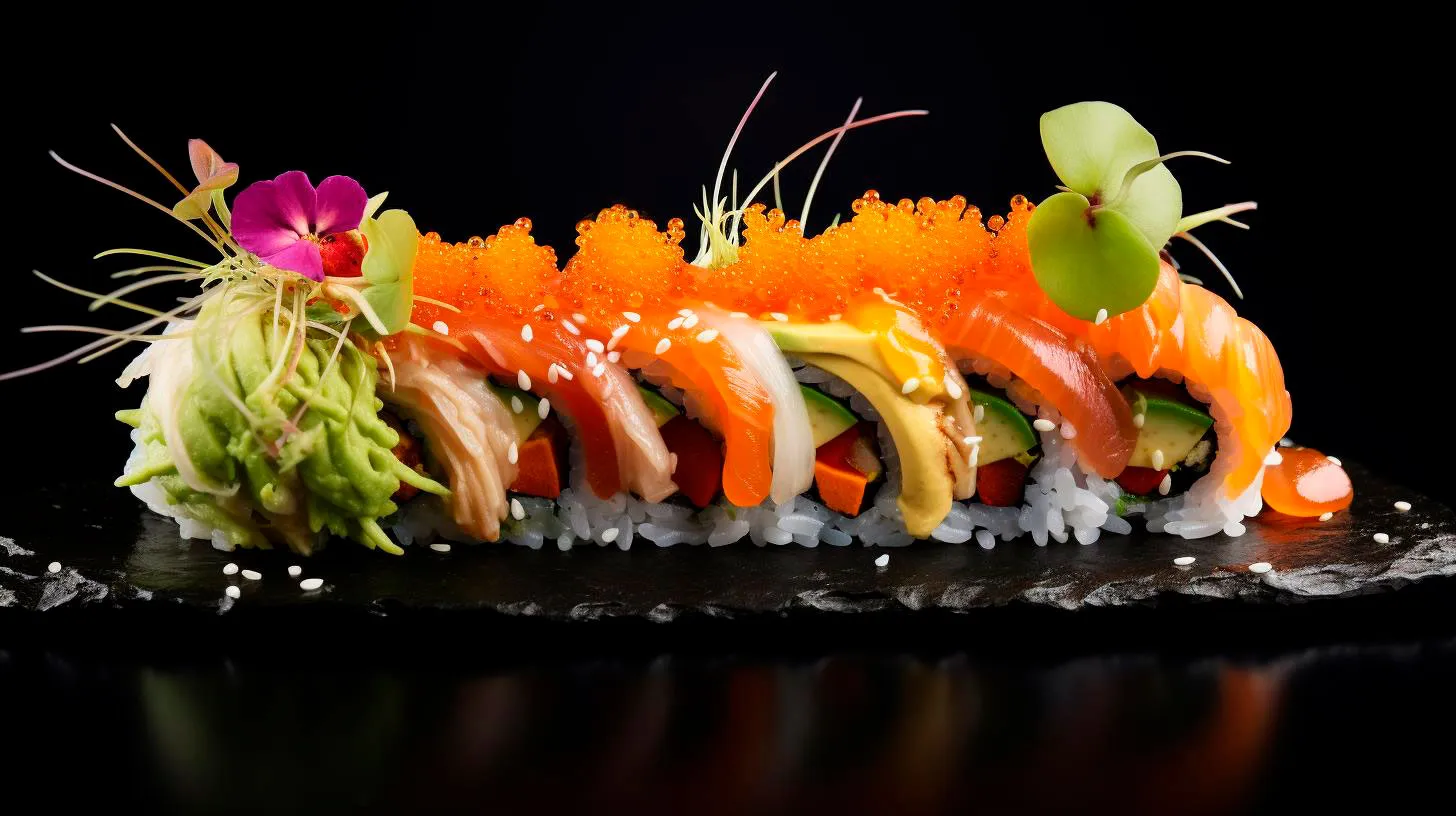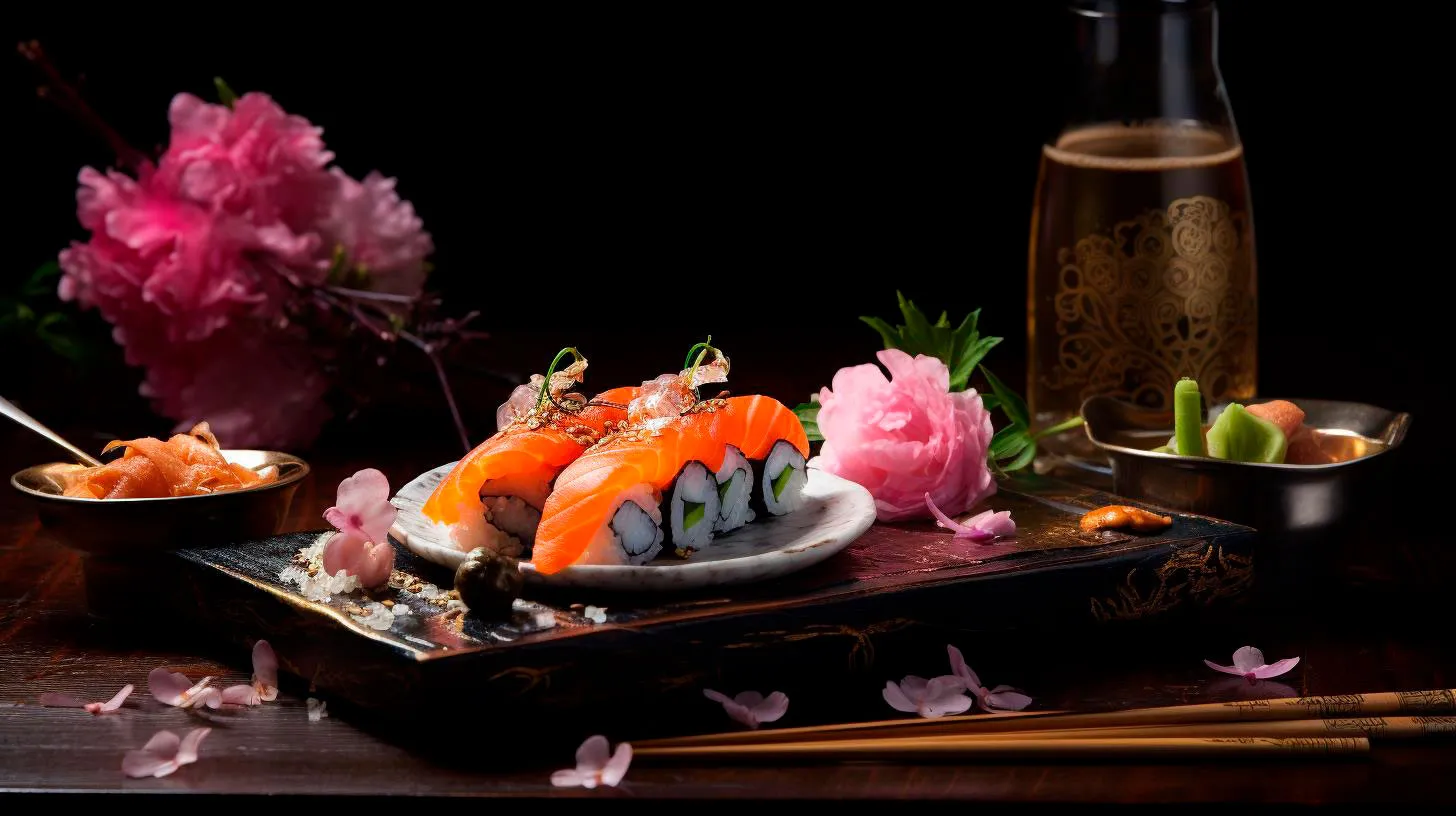Setting the Perfect Scene: Elevating Sushi to Epicurean Excellence
In this article, we delve into the art of creating the perfect sushi experience, elevating it to epicurean excellence.
Impeccable Ingredients for Unparalleled Flavors
At the heart of any outstanding sushi experience lies the quality and freshness of the ingredients. Sourcing the finest fish and seafood is of paramount importance when crafting sushi that transcends expectations. The vibrant flavors and delicate textures of sushi are best showcased when paired with high-grade ingredients, and they play a key role in defining the overall experience. Some key points to consider:
- Choose sushi-grade fish: Opt for top-notch, sushi-grade fish like tuna, salmon, and yellowtail to ensure optimal flavor and texture.
- Embrace variety: Incorporate a diverse range of seafood such as shrimp, scallops, and eel to provide a rich array of tastes and textures.
- Seek freshness: The quality and freshness of the ingredients can make or break the sushi experience. Ensuring proper storage and sourcing techniques is essential.
The Art of Rice Perfection
While the fish often takes center stage, the rice in sushi plays a crucial supporting role. Perfectly cooked and seasoned rice not only adds body and texture but also enhances the flavors of the accompanying ingredients. Here are some key pointers to elevate your sushi rice:
- Balance flavors with the right vinegar: The addition of rice vinegar and sugar to sushi rice creates a delicate and slightly sweet tang that complements the umami flavors of the fish.
- Master the rice cooking process: Achieving the ideal stickiness and firmness is crucial. Opting for short-grain sushi rice rinsed and cooked with precision helps set the stage for sublime sushi.
- Allow time for rice seasoning: Give the cooked rice a chance to absorb the flavors of the vinegar mixture by gently folding it while it cools down.
Introducing Innovation: Beyond Traditional Sushi
Sushi has come a long way from its traditional roots. Modern culinary masters are continuously pushing the boundaries, introducing innovative twists to the classic dish. By combining new and unexpected ingredients, chefs create exciting flavor profiles while keeping the fundamental elements of sushi intact. Here are a few inventive ideas to consider:
- Fusion rolls: Experiment with diverse culinary influences by incorporating ingredients like avocado, cream cheese, and even tropical fruits to add a unique dimension to your sushi rolls.
- Vegan and vegetarian options: Cater to a wider audience by offering sushi variations that feature plant-based proteins and vibrant vegetables. Think marinated tofu, grilled eggplant, or pickled radishes.
- Deconstructed sushi bowls: Present sushi in a fresh and appealing way by arranging sushi elements in a bowl format. This allows for endless creative combinations while maintaining the essence of sushi.
The Perfect Pairing: Sake and Sushi
No exceptional sushi experience is complete without the perfect beverage pairing. Sake, the renowned Japanese rice wine, has long been considered the traditional accompaniment to sushi. Its nuanced flavors and delicate aromas complement the delicacy of the dish, elevating the dining experience to new heights. Here are some key insights:
- Explore different sake types: With a wide range of sake styles available, experiment with junmai, ginjo, or daiginjo to discover the perfect match for your sushi selection.
- Consider temperature: Depending on the flavor profile of the sake and sushi, adjusting the serving temperature can optimize the pairing. Chilled, room temperature, or gently warmed – explore the options.
- Consult with sake experts: Engage the knowledge of sake experts to guide you through the nuances of selecting the right sake for your menu. Their insights can elevate the dining experience for your customers.
The Ultimate Sushi Experience: A Feast for the Senses
Setting the perfect scene for an exceptional sushi experience goes beyond the ingredients and techniques. It involves engaging all the senses of the diner, creating a feast that immerses them in the world of sushi. Here are some key takeaways:
- Aesthetically pleasing presentations: Sushi is not only about taste but also visual appeal. Take the time to create visually stunning presentations that reflect the artistry and attention to detail present in every bite.
- Engaging textures: Incorporate different textures, from the delicate softness of fish to the slight crunch of vegetables or the satisfying chewiness of sticky rice. The interplay between textures adds depth and interest to each bite.
- Interactive dining experiences: Offer sushi in formats that allow diners to engage and personalize their experience. Sushi bars with chefs creating rolls in front of customers or DIY sushi stations foster a sense of interaction and involvement.
Elevating sushi to epicurean excellence is an art form perfected by chefs who understand the nuance, precision, and creativity involved. By selecting impeccable ingredients, exploring innovation, embracing sake pairings, and creating a multisensory dining experience, you can set the stage for unforgettable moments of sheer culinary delight.
Unveiling the Intricacies Beyond the Basics of Sushi
The Art of Sushi
Sushi, originating from Japan, has gained immense popularity worldwide over the years. It is no longer just a delicacy found in traditional Japanese restaurants; it has become a global phenomenon. While most people are familiar with the classic sushi rolls, such as the California Roll and the Tuna Roll, there is so much more to discover in this captivating cuisine.
Now, let’s embark on a journey exploring some of the lesser-known types of sushi:
1. Nigiri
Nigiri is the epitome of sushi elegance. It consists of a hand-formed mound of sushi rice, delicately topped with a slice of raw or cooked seafood. The simplicity of this sushi allows the freshness and quality of the seafood to shine. Here are some key takeaways about nigiri:
- Nigiri showcases the skill of the sushi chef in forming the perfect mound of rice.
- The fish used in nigiri must be of premium quality, as it is the star of the dish.
- Popular types of nigiri include tuna, salmon, yellowtail, and eel.
2. Sashimi
Sashimi is a delicate and refined version of sushi that emphasizes the sheer flavor and texture of the fish. Unlike nigiri, sashimi does not include rice. Instead, thin slices of raw fish or seafood are expertly presented to showcase their natural taste. Here are some fascinating facts about sashimi:
- Sashimi is often served with soy sauce, wasabi, and pickled ginger to enhance the overall experience.
- Common types of fish used for sashimi include tuna, salmon, yellowtail, and mackerel.
- Freshness is key when enjoying sashimi, as it highlights the purity of the fish.
3. Temaki
Temaki, also known as hand rolls, are cone-shaped sushi rolls that are wrapped by hand. They are a popular choice for sushi lovers seeking a more interactive dining experience. Here’s why temaki is worth trying:
- Temaki allows diners to customize each roll to their personal taste by adding their preferred fillings.
- Popular temaki fillings include spicy tuna, crab, avocado, and cucumber.
- They are often enjoyed as a fun and casual option, perfect for social gatherings.
Mastering Sushi Etiquette
As with any treasured culinary tradition, sushi has its own set of customs and etiquette. To truly appreciate and respect this art form, it’s important to familiarize yourself with the following sushi etiquette:
- Use chopsticks or your hands, depending on the type of sushi. Nigiri and sashimi are typically enjoyed with chopsticks, while hand rolls can be eaten by hand.
- Dip sushi into soy sauce delicately, fish side-down, to avoid saturating the rice.
- Avoid adding excessive wasabi to soy sauce. Sushi chefs carefully apply the correct amount of wasabi for optimal flavor.
- Consume sushi in one bite, if possible, to experience the medley of flavors and textures intended by the chef.
Remember, practicing proper sushi etiquette enhances your gastronomic journey, showing respect for the chef’s craft and the culture behind this culinary art.
The Health Benefits of Sushi
Besides its delectable taste and exquisite presentation, sushi also offers numerous health benefits. Let’s explore some of the advantages of incorporating sushi into a balanced diet:
- Sushi is rich in omega-3 fatty acids, which promote heart health and reduce the risk of cardiovascular diseases.
- The seaweed wrap, known as nori, is a great source of iodine, essential for maintaining a healthy thyroid.
- Sushi is often packed with vegetables, promoting a high intake of vitamins, minerals, and fiber.
- Lean proteins like fish and shrimp are low in calories and high in essential nutrients.
By enjoying sushi as part of a well-rounded diet, you can savor its flavors while nourishing your body with wholesome ingredients.
Embrace Sushi’s Mystical Essence
Sushi is an art form that extends beyond its culinary appeal. It represents tradition, precision, and a deep respect for natural ingredients. From the masterful preparation techniques to the delicate balance of flavors, every bite unveils a story.
So, next time you indulge in sushi, take a moment to appreciate its beauty, savor its taste, and celebrate the rich cultural heritage it embodies. As you continue your sushi journey, may it serve as a reminder that true artistry lies in simplicity, and the most extraordinary experiences often arise from the intricacies hidden beyond the basics.
A Visual Feast: Captivating Presentation in Sushi Making
The Art of Sushi Presentation
When it comes to sushi making, presentation is key. Sushi chefs, also known as sushiya, take immense pride in presenting their creations in an aesthetically pleasing manner. The beauty of a well-plated sushi dish lies not only in its flavors but also in its visual appeal. The presentation of sushi is an art form in itself that requires a meticulous attention to detail.
Here are some key elements that make sushi presentation truly captivating:
- Colorful Ingredients: Sushi is renowned for its vibrant colors, which are derived from a variety of ingredients like fresh fish, seaweed, vegetables, and pickled ginger. The combination of these colorful elements adds visual interest to the dish and makes it visually enticing.
- Balance and Symmetry: Sushi chefs carefully arrange the ingredients to ensure a harmonious balance and symmetrical layout. Whether it’s a sushi roll or a nigiri, each component is thoughtfully placed to create a visually pleasing composition.
- Texture and Contrast: Sushi offers a delightful play of textures and contrasts. From the smooth texture of fish to the crunchy texture of tempura flakes, each bite is a sensory experience. The contrasting colors and flavors further enhance the overall appeal of the dish.
- Garnishes and Accents: Sushi chefs often use various garnishes and accents to elevate the presentation. These may include edible flowers, microgreens, sesame seeds, or even gold leaf. These small touches add a touch of sophistication and make the dish look even more enticing.
The WOW Factor: Taking Sushi Presentation to the Next Level
While traditional sushi presentation is already visually stunning, some sushi chefs push the boundaries to create jaw-dropping works of art. These innovative sushi creations are not only delicious but also awe-inspiring. Here are a few examples of sushi presentation that will leave you amazed:
1. Sushi Rolls as Art Canvases
Some sushi chefs treat sushi rolls as a canvas for their creativity. They skillfully create intricate patterns and designs using different colored fish, vegetables, and rice. These visually stunning rolls are a testament to the chef’s artistic talent and attention to detail.
2. Sushi in Unconventional Shapes
While sushi is typically served in traditional rectangular or cylindrical shapes, some chefs experiment with unique shapes to add an element of surprise. From sushi shaped like flowers or animals to sushi served in glass domes, these unconventional presentations take sushi to a whole new level.
3. Sushi Buffets with Elaborate Displays
For larger gatherings or special events, sushi buffets with elaborate displays are becoming increasingly popular. These displays feature massive sushi boats, towers, or even entire sushi landscapes. The grandeur of these presentations not only impresses guests but also creates an unforgettable dining experience.
The Key Takeaways
When it comes to sushi making, presentation plays a vital role in enhancing the overall dining experience. The combination of colors, balance, texture, and creative accents makes sushi a visual feast. Here are the key takeaways to remember:
- Colorful ingredients create visual interest and make sushi visually enticing.
- Balance and symmetry ensure a harmonious layout.
- Texture and contrast add depth and excitement to each bite.
- Garnishes and accents elevate the presentation, adding sophistication.
- Some sushi chefs take presentation to the next level, creating awe-inspiring works of art.
Next time you indulge in sushi, take a moment to appreciate the skill and creativity that goes into its presentation. A visually captivating sushi dish not only excites the palate but also enriches the overall dining experience, making it truly memorable.
The Delightful World of Breakfast: Mastering Morning Dining
In this article, we will delve into the delightful world of breakfast, exploring its benefits, options, and tips on how to master morning dining.
The Advantages of a Wholesome Breakfast
A well-balanced breakfast offers several advantages that can positively impact your day:
- Enhanced cognitive function: Consuming a nutritious breakfast can improve concentration, memory, and overall mental performance, setting you up for a productive day.
- Weight management: Eating a healthy breakfast can help control hunger and prevent overeating later in the day, supporting weight management goals.
- Improved mood: Breakfast boosts serotonin levels, the “feel-good” hormone, which can enhance your mood and overall well-being.
- Increase in energy levels: Providing your body with a mix of complex carbohydrates, protein, and healthy fats early in the day ensures you have the energy to tackle daily tasks.
Exploring Breakfast Options
Breakfast options are vast, catering to various tastes and dietary preferences. Here are some popular choices:
1. Classic American Breakfast
The traditional American breakfast typically includes eggs (scrambled, fried, or boiled), bacon or sausage, toast, and a side of fruits. It is a hearty option loved by many.
2. Continental Breakfast
A continental breakfast is common in hotels and comprises items like pastries, bread, cold cuts, fruits, yogurt, and cereals. It offers a wide range of choices for a quick and easy morning meal.
3. Mexican-inspired Breakfast
Mexican breakfast often showcases delicious dishes like huevos rancheros (fried eggs served with salsa and tortillas), chilaquiles (tortilla chips topped with sauce, cheese, and eggs), and breakfast burritos.
4. Healthy Options
If you prefer a healthier breakfast, you can opt for overnight oats with fruits and nuts, Greek yogurt with granola, avocado toast, or a fruit smoothie packed with vitamins and minerals.
Key Takeaways for a Masterful Morning Dining Experience
To make the most of your morning meal, consider these key takeaways:
- Prioritize protein: Including protein-rich foods like eggs, Greek yogurt, or lean meats in your breakfast provides satiety and helps repair and build body tissues.
- Load up on fiber: Incorporate whole grains, fruits, and vegetables to ensure you get a sufficient intake of fiber, aiding digestion and promoting gut health.
- Choose healthy fats: Avocado, nuts, and seeds are excellent sources of healthy fats, which support brain health and help absorb fat-soluble vitamins.
- Minimize added sugars: Many breakfast options, like sugary cereals or pastries, contain hidden sugars. Opt for natural sweetness from fruits and avoid excessive consumption of processed foods.
- Plan and prepare in advance: To save time in the morning, prep ingredients or meals the night before. This ensures you have a nutritious breakfast even on busy days.
Remember, breakfast is an opportunity to fuel your body and set a positive tone for the day. By making mindful choices and exploring different options, you can transform your morning dining experience into a delightful ritual that enhances your overall well-being.



